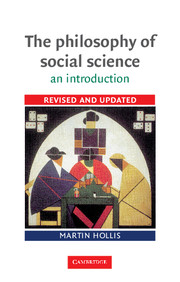Book contents
- Frontmatter
- 1 Introduction: problems of structure and action
- 2 Discovering truth: the rationalist way
- 3 Positive science: the empiricist way
- 4 Ants, spiders and bees: a third way?
- 5 Systems and functions
- 6 Games with rational agents
- 7 Understanding social action
- 8 Self and roles
- 9 Explaining and understanding
- 10 A value-neutral social science?
- 11 Rationality and relativism
- 12 Conclusion: two stories to tell
- Bibliography
- Index
3 - Positive science: the empiricist way
Published online by Cambridge University Press: 03 July 2012
- Frontmatter
- 1 Introduction: problems of structure and action
- 2 Discovering truth: the rationalist way
- 3 Positive science: the empiricist way
- 4 Ants, spiders and bees: a third way?
- 5 Systems and functions
- 6 Games with rational agents
- 7 Understanding social action
- 8 Self and roles
- 9 Explaining and understanding
- 10 A value-neutral social science?
- 11 Rationality and relativism
- 12 Conclusion: two stories to tell
- Bibliography
- Index
Summary
Bacon's first way of discovering truth scorned sense experience and started from 'the most general axioms'. That may have seemed perverse all along and it has certainly led us into difficulties. The second way beckons invitingly. Setting off from 'the senses and particulars' and 'rising by a gradual and unbroken ascent', it 'arrives at the most general axioms last of all'. Bacon speaks of it as 'the true way, but as yet untried'. It has been well tried since then, especially under the title of Positive science, and the aim of this chapter is to discover whether it is indeed the true way.
To show where we are heading, here is an example of the kind of explanation which lies along it. It comes from a 1970 textbook on scientific method for social scientists by A. Przeworski and H. Teune. Most of the book is a technical guide to the use of statistical models and inferences; but the authors helpfully distil the essence of their idea of explanation in an illustrative question and answer (1970, pp. 18-20 and 74-76). The question is: 'Why does Monsieur Rouget, age twenty four, blond hair, brown eyes, a worker in a large factory, vote Communist?' The answer is broadly that 'to explain the vote of M. Rouget, one must rely upon general probabilistic statements that are relevant for voting behaviour and have been sufficiently confirmed against various sets of evidence'.
- Type
- Chapter
- Information
- The Philosophy of Social ScienceAn Introduction, pp. 40 - 65Publisher: Cambridge University PressPrint publication year: 1994



